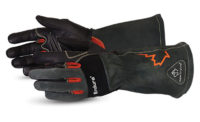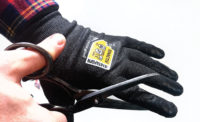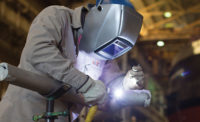Protect welders from burns, heat, UV rays & electricity

Welders have a unique set of hazards they need to protect themselves from – electricity, burns, heat, and ultraviolet rays, just to name a few.
Even with the proper precautions like flashback arrestors, exhaust hoods for fumes and gases, or fire extinguishers, welding carries a lot of risk. Needless to say, a good pair of gloves are as important to a welder as a welding hood – or at least they should be.
But choosing the right pair of gloves – especially with most purchases happening on the internet – can be tricky. This article identifies four tips features you need to consider when you’re purchasing welding gloves, to make sure that you’ll be safe and comfortable.
Tip #1: What type of welding are you doing?
TIG Welding
TIG welding is best for precision, like a structural weld. If your aim is a clean bead that needs little or no grinding, then this style of welding is a must. These highly-technical welds work great for short runs and on a variety of metals including aluminum, stainless steel and zinc anneal.
TIG welding gloves need to be thin. There isn’t as much heat being produced as MIG or stick and the runs aren’t nearly as long.
MIG Welding
MIG welding is great for high-volume production, for instance, if you’re completing a 10 to 15-foot run. MIG welding is also great for tacking pieces before completing the full weld. It doesn’t require as much clean up as stick welding and it can be used on thinner metal, like car doors.
MIG welding gloves need to have heat resistance. When you’re welding a longer run, the glove will absorb more radiant heat. A heavier, more insulated glove is key.
Stick Welding
Stick welding, also known as Shielded Metal Arc Welding (SMAW), is one of the world’s first and most widely used welding processes. Unlike TIG and MIG welding, stick welding produces the most heat, sparks and spatter.
Stick welding is a versatile process because it can be performed inside and outside and in remote areas. This makes it preferable for working on pipelines, refineries or ships. Stick welding is used to weld iron, steel and stainless steel, but can also be used to weld aluminum, nickel and copper alloys.
Stick welding gloves will also need heat resistance. Typically, your MIG welding gloves will work perfectly well to protect you during a long stick welding run. You may want to find gloves with longer cuffs depending on the amount of spatter being produced.
Tip #2: What type of leather is your glove made of?
Your welding gloves will almost certainly be leather. It’s the preferred material because of its high abrasion resistance, good heat properties and it won’t ignite. Different types of leather will have different properties, the two most popular leathers for welding are goat and cow.
Depending on the type of welding, here’s what you should consider:
Goat Grain
- Great for TIG welding because of its durability and touch sensitivity
- It’s not too thin like sheep’s skin but not as thick as cow grain
- Considered to be economical, strong and durable
Cow Grain
- Great for MIG and Stick welding because it is a thicker leather
- Cow grain is the most common leather and cost efficient
- Good for durability and comfort
Tip #3: Increase the lifespan of your gloves with Kevlar®.
In the glove world, Kevlar® is used for three main things:
- Cut resistance
- Seam stitching
- Heat resistance
Cut Protection
Cuts and lacerations are common in every industry. It’s not unheard of to have sharp of jagged edges on metal, especially during the prepping and grinding stages. A Kevlar® liner in your welding glove will add cut resistance without adding bulk.
Seam Stitching
The lifespan of a glove changes drastically depending on how much welding you do. Glove wear and tear is pretty common from heat and abrasion. Kevlar® is an excellent alternative to your typical cotton yarn for seams because of its high heat properties.
Tip #4: What type of insulation should you use?
A lot of heat is produced both during the prepping/grinding stages and the actual welding stage. The spark and heat being produced from the torch will also begin to heat up your glove over time. That means that the amount of insulation you’ll require depends on the amount of heat being produced.
Liner options
- Cotton Liner: Cotton is a good insulator for moderate temperature – upwards of 450°F. It will add some bulk to your glove but it is a cost-effective option.
- Kevlar® Liner: Kevlar® has an excellent reputation for heat resistance and doesn’t drip or melt even at 800°F. It also won’t add noticeable bulk to the glove. The Kevlar® lining will give the glove cut resistance, which can be beneficial when dealing with sharp metals.
- Aluminized Backing: For very high-heat welding applications like stick welding, an aluminized back will help to deflect heat away from the hands, which permits for longer runs and higher production.
Feeling a wave of serenity suddenly wash over you? It’s not surprising. That’s the feeling of confidence in choosing your next pair of welding gloves – regardless of the type.
Now that you’re equipped with the skills, you can surf the web without fear of buying the wrong pair of welding gloves. Enjoy!
Looking for a reprint of this article?
From high-res PDFs to custom plaques, order your copy today!





